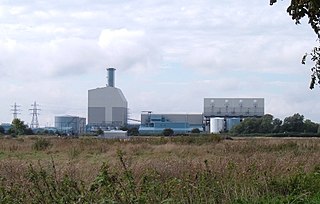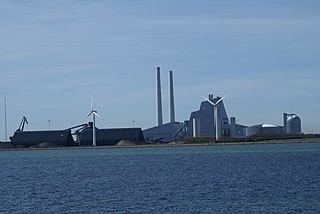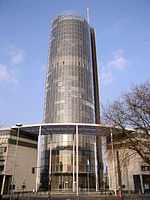
Aberthaw Power Station refers to two decommissioned coal-fired and co-fired biomass power stations on the coast of South Wales, near Barry in the Vale of Glamorgan. They were located at Limpert Bay, near the villages of Gileston and West Aberthaw. The most recent power station on the site, Aberthaw B Power Station, co-fired biomass and as of 2008 had a generating capacity of 1,560 megawatts (MW). The power station closed on 31 March 2020.

Lippendorf Power Station is a lignite-fired power station in Lippendorf, which is located in the municipality of Neukieritzsch, near Leipzig in Saxony, Germany. The power plant is owned and operated by Vattenfall Europe. It has a heating capacity of 330 MWt.

Niederaussem Power Station is a lignite-fired power station in the Bergheim Niederaussem/Rhein Erft circle, owned by RWE. It consisted of nine units, which were built between 1963 and 2003. It is the largest lignite coal power plant in operation in Germany, with total net capacity of 2,220 MW. The plant is estimated to have been one of the ten most carbon-polluting coal-fired power plants in the world in 2018, at 27.2 million tons of carbon dioxide, and its emissions intensity is estimated to be 45.1% higher relative to the average for all fossil-fueled plants in Germany. According to the study Dirty Thirty, issued in 2007 by the WWF, Niederaussem Power Station is the second-worst power station in Europe in terms of mercury emissions due to the use of lignite.

Frimmersdorf Power Station, located in Grevenbroich, is a decommissioned lignite-fired power station in Germany. The power station was one of the largest lignite-fired power stations in Germany. It had fourteen units with a total output capacity of 2,413 megawatts (MW). The chimneys of the power station are 200 metres high.

Peterhead Power Station is a multi-unit station owned and operated by SSE plc, with a capacity of 2,177 MW. It is located near Boddam and the A90, just south of Peterhead, in Aberdeenshire, in the northeast of Scotland. It stands next to Sandford Lodge, a circa-1800-built structure. Initially operating as an oil-fired power station and later transitioning to fossil gas, the plant has also served as a site for experimental hydrogen generation capacity.

King's Lynn Power Station refers to a combined cycle natural gas power station near King's Lynn in Norfolk, commissioned in 1997, and now owned by RWE, and to a coal fired power in King's Lynn in operation from 1899 to 1960. The CCGT station was mothballed on 1 April 2012. It can generate 325 MW of electricity and employed 40 people. The site was reopened on 19 November 2019.

Little Barford Power Station is a gas-fired power station just north of the village of Little Barford in Bedfordshire, England. It lies just south of the A428 St Neots bypass and east of the Wyboston Leisure Park. The River Great Ouse runs alongside. It was formerly the site of two coal-fired power stations, now demolished. The station is operated by RWE.

Great Yarmouth Power Station is combined cycle gas turbine power station on South Denes Road in Great Yarmouth in Norfolk, England, with a maximum output of 420 MW electricity, opened in 2001. It is built on the site of an oil-fired power station, built in 1958 and closed and demolished in the 1990s. A coal-fired power station was built in Great Yarmouth in 1894 and operated until 1961. The station is operated by RWE.

Blyth Power Station refers to a pair of now demolished coal-fired power stations, which were located on the Northumberland coast in North East England. The two stations were built alongside each other on a site near Cambois in Northumberland, on the northern bank of the River Blyth, between its tidal estuary and the North Sea. The stations took their name from the town of Blyth on the opposite bank of the estuary. Blyth A Power Station was built and opened first but had a smaller generating capacity than its sister station, Blyth B Power Station, which was built to its west four years later. The power stations' four large chimneys were a landmark of the Northumberland skyline for over 40 years; the A Station's two chimneys each stood at 140 metres (460 ft); the B Station's two chimneys were taller, at 170 metres (560 ft) each.

The Tilbury power stations were two thermal power stations on the north bank of the River Thames at Tilbury in Essex. The 360 MW dual coal- and oil-fired Tilbury A Power Station operated from 1956 until 1981 when it was mothballed, prior to demolition in 1999. The 1,428 MW Tilbury B Power Station operated between 1968 and 2013 and was fueled by coal, as well as co-firing with oil and, from 2011, biomass. Tilbury B was demolished in 2016–19. Since 2013 three other power stations have been proposed or constructed in Tilbury.

Hanasaari Power Plant is a decommissioned coal-fired cogeneration power plant in Sörnäinen, Helsinki, Finland. Its chimney has a height of 150 metres (490 ft). The plant was shut down on April 1, 2023, after the Helsinki City Council had voted for its closing back in 2015.

The Alholmens Kraft Power Station is a biomass power station in Alholmen, Jakobstad in Ostrobothnia region, Finland. It is the largest biomass cogeneration power station in the world.

The Avedøre Power Station is a combined heat and power station, located in Avedøre, Denmark, just south of Copenhagen, and is owned by Ørsted A/S. Avedøre Power Plant is a high-technology facility and one of the world's most efficient of its kind, being able to utilize as much as 94% of the energy in the fuel and convert 49% of the fuel energy into electricity. Apart from using petroleum (oil) and natural gas, the plant runs on a wide variety of biomass fuels such as straw and wood pellets. The plant consists of two units with a total capacity of 793 MW of electricity and 918 MW of heat. The combination of producing electricity and heat for district heating at the same time is widely used in Denmark and the rest of Scandinavia, due to the need of domestic heating together with the Danish energy companies putting a big effort into optimising the energy plants.

Mátra Power Plant, is a lignite fired power plant majority owned by MVM, the Hungarian state owned power company since 2019. It is located in the valley of the Mátra mountains, in Hungary. It has an installed electric power output of 950 MW, however, one 200 MW generator has been on permanent hiatus since January 2021. According to the latest government energy strategy, most of the existing lignite-fuelled units will be shut down in 2025, and a new 500 MW gas-fired unit will be added as well as up to 400 MW in solar power.

The total electricity consumption of the Netherlands in 2021 was 117 terawatt-hours (TWh). The consumption grew from 7 TWh in 1950 by an average of 4.5% per year. In 2021, fossil fuels, such as natural gas and coal, accounted for around 62% of the total electricity produced. Renewable energy sources, such as biomass, wind power, and solar power, produce 38% of the total electricity. One nuclear plant in Borssele is responsible for around 3% of total generation. More than 75% of electricity is produced centrally by thermal and nuclear units.

Despite the historic usage of wind power to drain water and grind grain, the Netherlands today lags 21 of the 26 other member states of the European Union in the consumption of energy from renewable sources. In 2022, the Netherlands consumed just 15% of its total energy from renewables. According to statistics published by Eurostat, it was the last among the EU countries in the shift away from global warming-inducing energy sources. The leading renewable sources in the country are biomass, wind, solar and both geothermal and aerothermal power. In 2018 decisions were made to replace natural gas as the main energy source in the Netherlands with increased electrification being a major part of this process.
Termosolar Borges is a hybrid biomass-parabolic trough solar thermal power plant which provides electricity to Spain's transmission system. It is located about 100 kilometres (62 mi) west of Barcelona, about 10 kilometres (6.2 mi) south-east of Lleida, near Les Borges Blanques, Catalonia, Spain.

Hungary is a member of the European Union and thus takes part in the EU strategy to increase its share of renewable energy. The EU has adopted the 2009 Renewable Energy Directive, which included a 20% renewable energy target by 2020 for the EU. By 2030 wind should produce in average 26-35% of the EU's electricity and save Europe €56 billion a year in avoided fuel costs. The national authors of Hungary forecast is 14.7% renewables in gross energy consumption by 2020, exceeding their 13% binding target by 1.7 percentage points. Hungary is the EU country with the smallest forecast penetration of renewables of the electricity demand in 2020, namely only 11%.
Denmark is a leading country in renewable energy production and usage. Renewable energy sources collectively produced 81% of Denmark's electricity generation in 2022, and are expected to provide 100% of national electric power production from 2030. Including energy use in the heating/cooling and transport sectors, Denmark is expected to reach 100% renewable energy in 2050, up from the 34% recorded in 2021.

The Vaskiluoto power stations complex situated on the Gulf of Bothnia island of Vaskiluoto in Vaasa, Finland, comprises three separate power stations connected to the Finnish national grid, Fingrid.




















